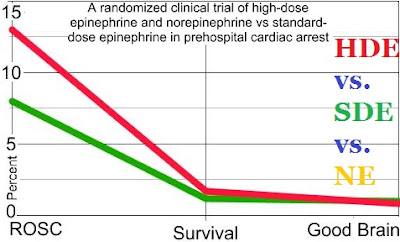The evidence for epinephrine (Adrenaline in Commonwealth countries) in anaphylaxis is not the highest quality available, but that does not mean that the use of epinephrine to treat anaphylaxis is not EBM (Evidence Based Medicine).
Image credit.
The patients are not randomized to placebo vs. epinephrine treatments, but EBM is not limited to placebo studies[1] – unless you believe that the Parachute Study is valid evidence, rather than just satire.[2]
It is entirely appropriate to use logical fallacy for satire, since humor is not expected to be based on valid evidence. It is definitely not appropriate to use logical fallacy as scientific evidence. Logic is essential to science, while logical fallacy and the avoidance of rational analysis are essential to deception.
What does the Parachute study have to do with Natural Alternatives to Epipen?[3] The evidence supporting epinephrine is even weaker than the evidence supporting parachutes, since one of the advantages of parachutes is that their use can be adequately studied without using human subjects. Therefore we actually have excellent evidence that parachutes will deploy as expected (with the obvious error bars that apply to valid science), will slow the descent (again, with the obvious error bars that apply to valid science), et cetera.
Even the most dimwitted purveyor of “natural” cures should know that and stay away from “natural” treatments for anaphylaxis, while the smarter snake oil salesmen also know that you can’t afford to mess around with a medical condition that can cause such rapid deterioration from seemingly perfectly health to dead. It’s not good for business.[4]
Ignoring the pathetic absence of evidence for alternative medicine, what is the evidence that epinephrine does improve outcomes?
There is an excellent discussion of the evidence in an article available for free at PubMed Central.
International guidelines concur that epinephrine (adrenaline) is the medication of first choice in anaphylaxis because it is the only medication that reduces hospitalization and death.[5]
There is no reduction of hospitalization and death with Benadryl (diphenhydramine), with any of the steroids, or with any alternative medicine. Go read the full paper.
Also, go read the analysis of the problems in the article advocating the use of Natural Alternatives to Epipen at Respectful Insolence.
–
Footnotes:
–
[1] Evidence based medicine: what it is and what it isn’t.
Sackett DL, Rosenberg WM, Gray JA, Haynes RB, Richardson WS.
BMJ. 1996 Jan 13;312(7023):71-2.
PMID: 8555924 [PubMed – indexed for MEDLINE]
Free Full Text from PubMed Central.
Evidence based medicine is the conscientious, explicit, and judicious use of current best evidence in making decisions about the care of individual patients. The practice of evidence based medicine means integrating individual clinical expertise with the best available external clinical evidence from systematic research.
Maybe the opponents of Evidence Based Medicine do not understand that using judgment to apply the best evidence to the patient is essential to EBM.
–
[2] Parachute use to prevent death and major trauma related to gravitational challenge: systematic review of randomised controlled trials.
Smith GC, Pell JP.
BMJ. 2003 Dec 20;327(7429):1459-61. Review.
PMID: 14684649 [PubMed – indexed for MEDLINE]
Free Full Text from PubMed Central.
The authors searched the literature for parachute research, but eliminated all studies without control groups, which suggests that EBM has some sort of requirement that all research include a control group. That is one of the logical fallacies employed by the authors for humorous intent.
We excluded studies that had no control group.
Those who cite the parachute study as valid evidence do not seem to understand this sleight of hand. EBM does not exclude studies that have no control group. EBM even includes expert opinion.
–
[3] Natural Alternatives to Epipen
Gazette Review
Dec 18, 2015
Adam Trent
Cached article
–
[4] Worst idea ever: “Natural” alternatives to the Epipen
Respectful Insolence
Posted by Orac
December 22, 2015
Article
–
[5] 2015 update of the evidence base: World Allergy Organization anaphylaxis guidelines.
Simons FE, Ebisawa M, Sanchez-Borges M, Thong BY, Worm M, Tanno LK, Lockey RF, El-Gamal YM, Brown SG, Park HS, Sheikh A.
World Allergy Organ J. 2015 Oct 28;8(1):32. doi: 10.1186/s40413-015-0080-1. eCollection 2015.
PMID: 26525001
Free Full Text from PubMed Central.
.












Subscribe to RogueMedic.com